Blog
Essential Diabetic Foot Care
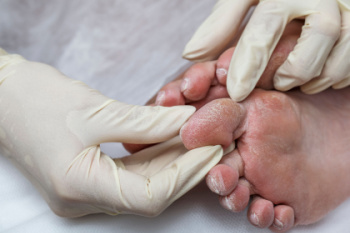
Regular foot care is essential for people with diabetes, as high blood sugar can lead to nerve damage known as neuropathy, and poor circulation, making feet more vulnerable to injury and infection. Symptoms often include numbness, tingling, or a loss of sensation in the feet, making it difficult to feel cuts, blisters, or sores. If left untreated, even minor injuries can lead to serious complications, including ulcers and infections. The primary causes of foot issues in diabetics patients are nerve damage, poor circulation, and reduced ability to heal wounds. Diabetic individuals may also experience dry skin, calluses, or fungal infections. A podiatrist can provide essential care, including regular foot exams, wound care, and preventative treatments. They may recommend custom shoes or orthotics to reduce pressure points, prescribe medications for infections, and teach proper foot hygiene techniques. If you have diabetes, it is suggested that you are under the care of a podiatrist who can help you to manage this serious condition.
Diabetic foot care is important in preventing foot ailments such as ulcers. If you are suffering from diabetes or have any other concerns about your feet, contact one of our podiatrists from New York Foot and Ankle. Our doctors can provide the care you need to keep you pain-free and on your feet.
Diabetic Foot Care
Diabetes affects millions of people every year. The condition can damage blood vessels in many parts of the body, especially the feet. Because of this, taking care of your feet is essential if you have diabetes, and having a podiatrist help monitor your foot health is highly recommended.
The Importance of Caring for Your Feet
- Routinely inspect your feet for bruises or sores.
- Wear socks that fit your feet comfortably.
- Wear comfortable shoes that provide adequate support.
Patients with diabetes should have their doctor monitor their blood levels, as blood sugar levels play such a huge role in diabetic care. Monitoring these levels on a regular basis is highly advised.
It is always best to inform your healthcare professional of any concerns you may have regarding your feet, especially for diabetic patients. Early treatment and routine foot examinations are keys to maintaining proper health, especially because severe complications can arise if proper treatment is not applied.
If you have any questions please feel free to contact one of our offices located in Franklin Square, Bethpage, Brooklyn, and Massapequa, NY . We offer the newest diagnostic and treatment technologies for all your foot and ankle needs.
Dangers of Tophi From Chronic Gout
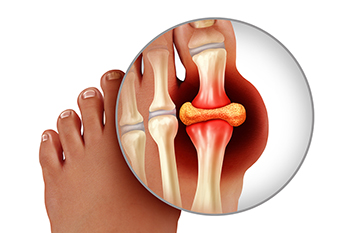
Tophi are firm, often painless lumps that can develop around the joints, especially in the feet, toes, and ankles, in people with advanced gout. These nodules form when uric acid crystallizes and accumulates over time, creating hardened deposits beneath the skin. While initially they may not cause discomfort, larger tophi can lead to joint instability, limited movement, and significant pain. The skin over a tophus may become stretched and thin, and in some cases, it can ulcerate, exposing a chalky substance inside. Without treatment, tophi can erode bone and cartilage, resulting in chronic inflammation and joint deformity. A podiatrist can diagnose and manage tophi by evaluating joint damage, guiding treatment to reduce uric acid levels, and performing surgical removal if needed. Addressing tophi early can help prevent further complications and restore mobility. If you frequently have painful gout flare-ups, it is suggested that you schedule an appointment with a podiatrist for treatment options.
Gout is a painful condition that can be treated. If you are seeking treatment, contact one of our podiatrists from New York Foot and Ankle. Our doctors will treat your foot and ankle needs.
What Is Gout?
Gout is a form of arthritis that is characterized by sudden, severe attacks of pain, redness, and tenderness in the joints. The condition usually affects the joint at the base of the big toe. A gout attack can occur at any random time, such as the middle of the night while you are asleep.
Symptoms
- Intense Joint Pain - Usually around the large joint of your big toe, and it most severe within the first four to twelve hours
- Lingering Discomfort - Joint discomfort may last from a few days to a few weeks
- Inflammation and Redness -Affected joints may become swollen, tender, warm and red
- Limited Range of Motion - May experience a decrease in joint mobility
Risk Factors
- Genetics - If family members have gout, you’re more likely to have it
- Medications - Diuretic medications can raise uric acid levels
- Gender/Age - Gout is more common in men until the age of 60. It is believed that estrogen protects women until that point
- Diet - Eating red meat and shellfish increases your risk
- Alcohol - Having more than two alcoholic drinks per day increases your risk
- Obesity - Obese people are at a higher risk for gout
Prior to visiting your podiatrist to receive treatment for gout, there are a few things you should do beforehand. If you have gout you should write down your symptoms--including when they started and how often you experience them, important medical information you may have, and any questions you may have. Writing down these three things will help your podiatrist in assessing your specific situation so that he or she may provide the best route of treatment for you.
If you have any questions, please feel free to contact one of our offices located in Franklin Square, Bethpage, Brooklyn, and Massapequa, NY . We offer the newest diagnostic and treatment technologies for all your foot care needs.
Symptoms and Diagnosis of Toenail Fungus
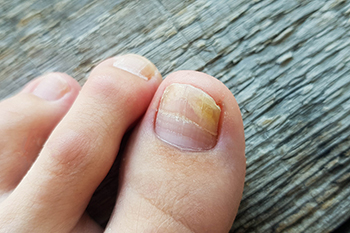
Toenail fungus, also known as onychomycosis, is a fungal infection that affects the nails, typically starting at the tip and spreading deeper into the nail. The primary cause is exposure to fungi, which thrive in warm, moist environments such as public showers or pools. Toenail fungus is more common in individuals with weakened immune systems, poor circulation, or those who wear tight, non-breathable shoes. Symptoms include thickened nails, discoloration, crumbling edges, and sometimes a foul odor. The nail may become detached from the nail bed in severe cases. Diagnosis is usually made through a physical examination, and a sample of the infected nail may be taken for laboratory testing, such as a fungal culture or nail biopsy, to confirm the presence of the fungus. If you have symptoms of toenail fungus, it is suggested that you promptly schedule an appointment with a podiatrist who can accurately diagnose and treat this condition, which may include prescribed medication.
If left untreated, toenail fungus may spread to other toenails, skin, or even fingernails. If you suspect you have toenail fungus it is important to seek treatment right away. For more information about treatment, contact one of our podiatrists of New York Foot and Ankle. Our doctors can provide the care you need to keep you pain-free and on your feet.
Symptoms
- Warped or oddly shaped nails
- Yellowish nails
- Loose/separated nail
- Buildup of bits and pieces of nail fragments under the nail
- Brittle, broken, thickened nail
Treatment
If self-care strategies and over-the-counter medications does not help your fungus, your podiatrist may give you a prescription drug instead. Even if you find relief from your toenail fungus symptoms, you may experience a repeat infection in the future.
Prevention
In order to prevent getting toenail fungus in the future, you should always make sure to wash your feet with soap and water. After washing, it is important to dry your feet thoroughly especially in between the toes. When trimming your toenails, be sure to trim straight across instead of in a rounded shape. It is crucial not to cover up discolored nails with nail polish because that will prevent your nail from being able to “breathe”.
In some cases, surgical procedure may be needed to remove the toenail fungus. Consult with your podiatrist about the best treatment options for your case of toenail fungus.
If you have any questions, please feel free to contact one of our offices located in Franklin Square, Bethpage, Brooklyn, and Massapequa, NY . We offer the newest diagnostic and treatment technologies for all your foot care needs.
Heel Pain Can Be Treated!
Prioritizing Falls Prevention for Seniors
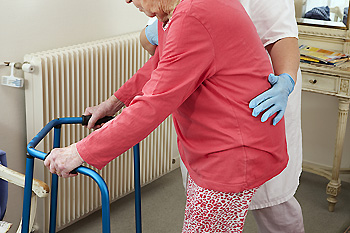
Falls prevention for the elderly is a critical issue, especially as the aging population grows worldwide. Falls are a leading cause of injury and hospitalization among seniors, often resulting in fractures, head injuries, and a loss of independence. The topic has gained prominence due to the rising healthcare costs and the strain on medical systems. Factors like declining balance, reduced muscle strength, vision problems, and unsafe home environments contribute to the risk. Preventing falls involves regular physical activity to improve strength and coordination, wearing supportive footwear, and making homes safer with grab bars and proper lighting. Routine health checks to address vision, medications, and foot health also play a vital role. If you are a senior, it is suggested that you schedule regular visits to a podiatrist to address any issues associated with your feet and ankles that may contribute to the risk of falls.
Preventing falls among the elderly is very important. If you are older and have fallen or fear that you are prone to falling, consult with one of our podiatrists from New York Foot and Ankle. Our doctors will assess your condition and provide you with quality advice and care.
Every 11 seconds, an elderly American is being treated in an emergency room for a fall related injury. Falls are the leading cause of head and hip injuries for those 65 and older. Due to decreases in strength, balance, senses, and lack of awareness, elderly persons are very susceptible to falling. Thankfully, there are a number of things older persons can do to prevent falls.
How to Prevent Falls
Some effective methods that older persons can do to prevent falls include:
- Enrolling in strength and balance exercise program to increase balance and strength
- Periodically having your sight and hearing checked
- Discuss any medications you have with a doctor to see if it increases the risk of falling
- Clearing the house of falling hazards and installing devices like grab bars and railings
- Utilizing a walker or cane
- Wearing shoes that provide good support and cushioning
- Talking to family members about falling and increasing awareness
Falling can be a traumatic and embarrassing experience for elderly persons; this can make them less willing to leave the house, and less willing to talk to someone about their fears of falling. Doing such things, however, will increase the likelihood of tripping or losing one’s balance. Knowing the causes of falling and how to prevent them is the best way to mitigate the risk of serious injury.
If you have any questions, please feel free to contact one of our offices located in Franklin Square, Bethpage, Brooklyn, and Massapequa, NY . We offer the newest diagnostic and treatment technologies for all your foot care needs.
Causes and Symptoms of Ankle Arthritis
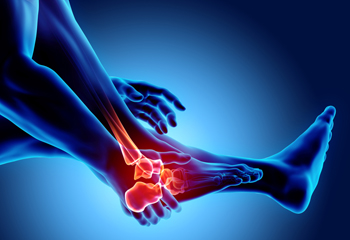
Ankle arthritis is a condition where the joints in the ankle become inflamed, causing pain, stiffness, and limited mobility. It occurs when the cartilage that cushions the bones in the ankle wears down over time, leading to direct contact between the bones. The most common causes of ankle arthritis include previous injuries, such as sprains or fractures, which can damage the joint and increase the risk of arthritis. Other contributing factors include age, genetics, and inflammatory conditions like rheumatoid arthritis. Symptoms of ankle arthritis typically include pain, especially after activity, swelling, and a decrease in range of motion. People with this condition may also experience difficulty walking, instability, and a feeling of weakness in the ankle. Managing ankle arthritis often involves a combination of medication, and in severe cases, surgery to improve mobility and reduce pain. If you have ankle pain, it is suggested that you consult a podiatrist who can accurately diagnose ankle arthritis and manage it accordingly.
Arthritis can be a difficult condition to live with. If you are seeking treatment, contact one of our podiatrists from New York Foot and Ankle. Our doctors can provide the care you need to keep you pain-free and on your feet.
Arthritic Foot Care
Arthritis is a term that is commonly used to describe joint pain. The condition itself can occur to anyone of any age, race, or gender, and there are over 100 types of it. Nevertheless, arthritis is more commonly found in women compared to men, and it is also more prevalent in those who are overweight. The causes of arthritis vary depending on which type of arthritis you have. Osteoarthritis for example, is often caused by injury, while rheumatoid arthritis is caused by a misdirected immune system.
Symptoms
- Swelling
- Pain
- Stiffness
- Decreased Range of Motion
Arthritic symptoms range in severity, and they may come and go. Some symptoms stay the same for several years but could potentially get worse with time. Severe cases of arthritis can prevent its sufferers from performing daily activities and make walking difficult.
Risk Factors
- Occupation – Occupations requiring repetitive knee movements have been linked to osteoarthritis
- Obesity – Excess weight can contribute to osteoarthritis development
- Infection – Microbial agents can infect the joints and trigger arthritis
- Joint Injuries – Damage to joints may lead to osteoarthritis
- Age – Risk increases with age
- Gender –Most types are more common in women
- Genetics – Arthritis can be hereditary
If you suspect your arthritis is affecting your feet, it is crucial that you see a podiatrist immediately. Your doctor will be able to address your specific case and help you decide which treatment method is best for you.
If you have any questions, please feel free to contact one of our offices located in Franklin Square, Bethpage, Brooklyn, and Massapequa, NY . We offer the newest diagnostic and treatment technologies for all your foot care needs.
Proper Footwear for Restaurant Workers

For restaurant workers, wearing the right footwear is essential for both comfort and safety. Long hours spent on hard, slippery floors can put significant strain on the feet, legs, and lower back. Proper footwear helps to cushion the feet, reduce fatigue, and prevent injuries such as sprains, strains, and blisters. Shoes with good arch support, non-slip soles, and a proper fit can improve posture and alignment, reducing the risk of developing chronic pain or foot conditions. Additionally, slip-resistant shoes help prevent accidents in environments where spills and wet floors are common. Over time, wearing inadequate footwear can lead to more serious problems such as plantar fasciitis, bunions, or even stress fractures. If you have sustained a foot or ankle injury during your workday, it is suggested that you consult a podiatrist who can treat various foot conditions, and guide you on appropriate footwear choices.
While working on the feet, it is important to take the proper care of them. For more information about working on your feet, contact one of our podiatrists from New York Foot and Ankle. Our doctors will treat your foot and ankle needs.
Working on Your Feet
Standing on your feet for long periods of time can cause stress and pain in your feet. Your whole body may experience change in terms of posture, back pain, bunions, callouses and or plantar warts. There are ways to avoid these conditions with proper foot care, smart choices and correct posture.
Positive Changes
Negative heeled shoe – Choosing this shoe type places the heel slightly lower than the ball of the foot. These are great for overall foot health. Find shoes that fit you correctly.
Go barefoot – Our feet were not designed to be enclosed for all hours of the day. Try to periodically expose your feet to air.
Eliminate Pain
Foot Exercises – Performing simple exercises, incorporating yoga and doing stretches are beneficial. This will allow increased blood flow to the area and muscles of the foot.
Achilles tendon – Stretching the foot out flat on the floor will relax the calf muscles and tendon. These exercises can be performed almost anywhere. Make sure you add these exercises to your daily regimen.
With a little bit of this information and knowing more about foot health, you will notice changes. Foot stretches and proper footwear will help with pain and prevent further issues.
If you have any questions please feel free to contact one of our offices located in Franklin Square, Bethpage, Brooklyn, and Massapequa, NY . We offer the newest diagnostic and treatment technologies for all your foot and ankle needs.
Causes and Associated Conditions of Hammertoe
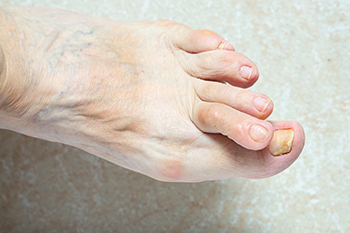
Hammertoe is a deformity in which one or more toes bend downward at the middle joint, causing a claw-like appearance. This condition can result from a variety of causes, including muscle imbalances, poor footwear choices, or inherited traits. In some cases, hammertoe is associated with underlying health conditions such as rheumatoid arthritis, or RA, where joint inflammation can lead to deformities in the toes. Charcot-Marie-Tooth disease, a genetic disorder that affects peripheral nerves, can also cause muscle weakness and imbalance, contributing to the development of hammertoe. Another common cause is an elongated second metatarsal bone, which can lead to abnormal pressure on the toes, causing them to bend. Symptoms of hammertoe include pain, difficulty walking, and corns or calluses forming on the affected toes. If you have developed a hammertoe, it is suggested that you consult a podiatrist who may guide you toward wearing corrective footwear, splints, or, in severe cases, surgery to realign the toe.
Hammertoes can be a painful condition to live with. For more information, contact one of our podiatrists of New York Foot and Ankle. Our doctors will answer any of your foot- and ankle-related questions.
Hammertoe
Hammertoe is a foot deformity that occurs due to an imbalance in the muscles, tendons, or ligaments that normally hold the toe straight. It can be caused by the type of shoes you wear, your foot structure, trauma, and certain disease processes.
Symptoms
- Painful and/or difficult toe movement
- Swelling
- Joint stiffness
- Calluses/Corns
- Physical deformity
Risk Factors
- Age – The risk of hammertoe increases with age
- Sex – Women are more likely to have hammertoe compared to men
- Toe Length – You are more likely to develop hammertoe if your second toe is longer than your big toe
- Certain Diseases – Arthritis and diabetes may make you more likely to develop hammertoe
Treatment
If you have hammertoe, you should change into a more comfortable shoe that provides enough room for your toes. Exercises such as picking up marbles may strengthen and stretch your toe muscles. Nevertheless, it is important to seek assistance from a podiatrist in order to determine the severity of your hammertoe and see which treatment option will work best for you.
If you have any questions, please feel free to contact one of our offices located in Franklin Square, Bethpage, Brooklyn, and Massapequa, NY . We offer the newest diagnostic and treatment technologies for all your foot care needs.
Reminder: When Was the Last Time...?
Changes in Foot Growth During Pregnancy
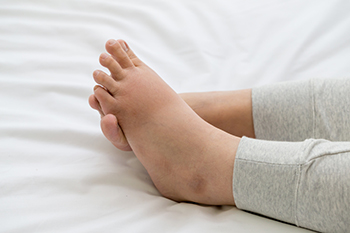
Many women notice changes in their feet during pregnancy, often leading to the question of whether their feet actually grow. The answer is yes, as hormonal changes and weight gain can cause the ligaments in the feet to relax, leading to a widening and lengthening of the foot. This is largely due to the hormone relaxin, which prepares the body for childbirth by loosening ligaments. Additionally, the increased weight and fluid retention can contribute to swelling. For some women, feet may return to their pre-pregnancy size after childbirth, while others find their feet remain larger permanently. This lasting change can be attributed to factors such as age, genetics, and the amount of weight gained during pregnancy. If you have developed foot pain or other foot problems during your pregnancy, it is suggested that you contact a podiatrist who can offer you effective relief solutions.
Pregnant women with swollen feet can be treated with a variety of different methods that are readily available. For more information about other cures for swollen feet during pregnancy, consult with one of our podiatrists from New York Foot and Ankle. Our doctors will attend to all of your foot and ankle needs.
What Foot Problems Can Arise During Pregnancy?
One problem that can occur is overpronation, which occurs when the arch of the foot flattens and tends to roll inward. This can cause pain and discomfort in your heels while you’re walking or even just standing up, trying to support your baby.
Another problem is edema, or swelling in the extremities. This often affects the feet during pregnancy but tends to occur in the later stages.
How Can I Keep My Feet Healthy During Pregnancy?
- Wearing orthotics can provide extra support for the feet and help distribute weight evenly
- Minimize the amount of time spent walking barefoot
- Wear shoes with good arch support
- Wear shoes that allow for good circulation to the feet
- Elevate feet if you experience swelling
- Massage your feet
- Get regular, light exercise, such as walking, to promote blood circulation to the feet
If you have any questions please feel free to contact one of our offices located in Franklin Square, Bethpage, Brooklyn, and Massapequa, NY . We offer the newest diagnostic and treatment technologies for all your foot and ankle needs.
More...
Tips for Choosing Running Shoes as a Beginner

For beginners, selecting the right running shoes is essential for comfort and injury prevention. First, consider the type of running you plan to do, whether it is road running, trail running, or casual jogging. Each type requires specific features tailored to different terrains. Stability features are important for those who overpronate, as they help maintain proper alignment and support the foot's arch. Look for shoes with cushioning to absorb impact and provide comfort during longer runs. Motion control features are beneficial for individuals with flat feet or severe overpronation, offering extra support to prevent excessive rolling inward. Trying on multiple pairs and considering foot shape and size is vital for finding the perfect fit. If you have injured your foot or ankle while running, it is suggested that you consult a podiatrist who can treat various foot conditions, and guide you on how to choose the right running shoe.
If you are a runner, wearing the right running shoe is essential. For more information, contact one of our podiatrists from New York Foot and Ankle. Our doctors can provide the care you need to keep you pain-free and on your feet.
Choosing the Right Running Shoe for Your Foot Type
To increase performance and avoid the risk of injury, it is important to choose the right running shoe based on your foot type. The general design of running shoes revolves around pronation, which is how the ankle rolls from outside to inside when the foot strikes the ground.
- Neutral runners are able to choose from a wide variety of shoes, including minimalist shoes or even going barefoot.
- Runners who overpronate, or experience an over-abundance of ankle rolling, should choose shoes that provide extra motion control and stability.
- Runners who underpronate, or supinate, have feet that have high arches and lack flexibility, preventing shock absorption. They require shoes with more flexibility and cushion.
If you have any questions please feel free to contact one of our offices located in Franklin Square, Bethpage, Brooklyn, and Massapequa, NY . We offer the newest diagnostic and treatment technologies for all your foot and ankle needs.
Ankle Sprains in Volleyball

Ankle sprains are common injuries in volleyball, often occurring during jumps or quick lateral movements. These sprains are classified into three grades, each reflecting the severity of the injury. A Grade 1 sprain involves mild stretching of the ligaments, typically resulting in minor pain and swelling, with recovery usually taking a few days to a week. A Grade 2 sprain indicates a partial tear of the ligaments, causing moderate pain and swelling, often requiring two to four weeks for healing. A Grade 3 sprain represents a complete tear, leading to severe pain and instability, and may take six weeks or more to recover. Stopping the activity, avoiding putting weight on the foot, and wrapping the ankle to reduce swelling may help to bring relief. If you enjoy playing volleyball, and have sustained an ankle sprain, it is suggested that you promptly schedule an appointment with a podiatrist who can guide you toward specific treatment solutions.
Sports related foot and ankle injuries require proper treatment before players can go back to their regular routines. For more information, contact one of our podiatrists of New York Foot and Ankle. Our doctors can provide the care you need to keep you pain-free and on your feet.
Sports Related Foot and Ankle Injuries
Foot and ankle injuries are a common occurrence when it comes to athletes of any sport. While many athletes dismiss the initial aches and pains, the truth is that ignoring potential foot and ankle injuries can lead to serious problems. As athletes continue to place pressure and strain the area further, a mild injury can turn into something as serious as a rupture and may lead to a permanent disability. There are many factors that contribute to sports related foot and ankle injuries, which include failure to warm up properly, not providing support or wearing bad footwear. Common injuries and conditions athletes face, including:
- Plantar Fasciitis
- Plantar Fasciosis
- Achilles Tendinitis
- Achilles Tendon Rupture
- Ankle Sprains
Sports related injuries are commonly treated using the RICE method. This includes rest, applying ice to the injured area, compression and elevating the ankle. More serious sprains and injuries may require surgery, which could include arthroscopic and reconstructive surgery. Rehabilitation and therapy may also be required in order to get any recovering athlete to become fully functional again. Any unusual aches and pains an athlete sustains must be evaluated by a licensed, reputable medical professional.
If you have any questions please feel free to contact one of our offices located in Franklin Square, Bethpage, Brooklyn, and Massapequa, NY . We offer the newest diagnostic and treatment technologies for all your foot and ankle needs.
First Morning Step Can Signal Plantar Fasciitis
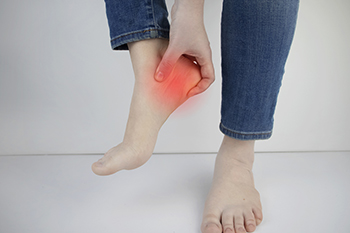
Heel pain, especially first thing in the morning, can often be a sign of plantar fasciitis. This condition occurs when the plantar fascia, a wide band of tissue that runs from your heel to your toes, becomes inflamed or develops small tears. The pain can be sharp, particularly with the first steps after getting out of bed, but it often recedes as you move throughout the day. Plantar fasciitis is more common among people who are overweight, older adults, and athletes, especially those who run on hard surfaces. A podiatrist can help by diagnosing plantar fasciitis through an exam. This foot doctor may recommend treatment that includes certain stretches, choosing more supportive footwear, or taking prescription-strength anti-inflammatory medication. These treatment methods aim to reduce inflammation and support the tissue's healing process. If you have heel pain first thing in the morning, it is suggested that you visit a podiatrist for an exam to find out if you have plantar fasciitis.
Plantar fasciitis is a common foot condition that is often caused by a strain injury. If you are experiencing heel pain or symptoms of plantar fasciitis, contact one of our podiatrists from New York Foot and Ankle. Our doctors can provide the care you need to keep you pain-free and on your feet.
What Is Plantar Fasciitis?
Plantar fasciitis is one of the most common causes of heel pain. The plantar fascia is a ligament that connects your heel to the front of your foot. When this ligament becomes inflamed, plantar fasciitis is the result. If you have plantar fasciitis you will have a stabbing pain that usually occurs with your first steps in the morning. As the day progresses and you walk around more, this pain will start to disappear, but it will return after long periods of standing or sitting.
What Causes Plantar Fasciitis?
- Excessive running
- Having high arches in your feet
- Other foot issues such as flat feet
- Pregnancy (due to the sudden weight gain)
- Being on your feet very often
There are some risk factors that may make you more likely to develop plantar fasciitis compared to others. The condition most commonly affects adults between the ages of 40 and 60. It also tends to affect people who are obese because the extra pounds result in extra stress being placed on the plantar fascia.
Prevention
- Take good care of your feet – Wear shoes that have good arch support and heel cushioning.
- Maintain a healthy weight
- If you are a runner, alternate running with other sports that won’t cause heel pain
There are a variety of treatment options available for plantar fasciitis along with the pain that accompanies it. Additionally, physical therapy is a very important component in the treatment process. It is important that you meet with your podiatrist to determine which treatment option is best for you.
If you have any questions, please feel free to contact one of our offices located in Franklin Square, Bethpage, Brooklyn, and Massapequa, NY . We offer the newest diagnostic and treatment technologies for all your foot care needs.
Diagnosis and Treatment of Diabetic Neuropathy
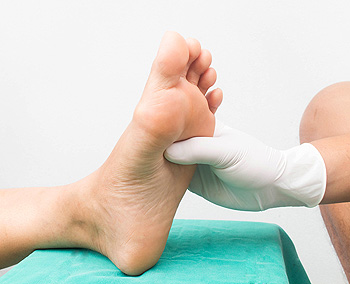
Diabetic neuropathy occurs when high blood sugar levels damage the nerves in the feet, leading to symptoms such as numbness, tingling, and burning sensations. A podiatrist can diagnose diabetic neuropathy through various tests. Included are checking the response of your feet to temperature, touch, and reflexes to assess nerve function. Although nerve damage cannot be reversed, a podiatrist can help reduce the risk of complications by recommending regular foot inspections, managing foot ulcers promptly, and ensuring proper foot hygiene. Choosing the right footwear and inspecting shoes for potential hazards are also key steps in preventing further complications. Regular visits to a podiatrist can help monitor foot health and provide proper treatment should infections or deformities arise. If you have diabetic neuropathy that affects your feet, it is suggested that you make a podiatrist a part of your medical team to manage this condition.
Neuropathy
Neuropathy can be a potentially serious condition, especially if it is left undiagnosed. If you have any concerns that you may be experiencing nerve loss in your feet, consult with one of our podiatrists from New York Foot and Ankle. Our doctors will assess your condition and provide you with quality foot and ankle treatment for neuropathy.
What Is Neuropathy?
Neuropathy is a condition that leads to damage to the nerves in the body. Peripheral neuropathy, or neuropathy that affects your peripheral nervous system, usually occurs in the feet. Neuropathy can be triggered by a number of different causes. Such causes include diabetes, infections, cancers, disorders, and toxic substances.
Symptoms of Neuropathy Include:
- Numbness
- Sensation loss
- Prickling and tingling sensations
- Throbbing, freezing, burning pains
- Muscle weakness
Those with diabetes are at serious risk due to being unable to feel an ulcer on their feet. Diabetics usually also suffer from poor blood circulation. This can lead to the wound not healing, infections occurring, and the limb may have to be amputated.
Treatment
To treat neuropathy in the foot, podiatrists will first diagnose the cause of the neuropathy. Figuring out the underlying cause of the neuropathy will allow the podiatrist to prescribe the best treatment, whether it be caused by diabetes, toxic substance exposure, infection, etc. If the nerve has not died, then it’s possible that sensation may be able to return to the foot.
Pain medication may be issued for pain. Electrical nerve stimulation can be used to stimulate nerves. If the neuropathy is caused from pressure on the nerves, then surgery may be necessary.
If you have any questions, please feel free to contact one of our offices located in Franklin Square, Bethpage, Brooklyn, and Massapequa, NY . We offer the newest diagnostic and treatment technologies for all your foot care needs.


